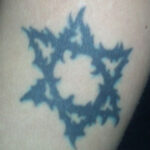Anthony Bourdain, the celebrated chef, author, and television personality, was known for his adventurous spirit and candid storytelling. Beyond his culinary expertise and worldly travels, Bourdain’s body art offered another layer to his complex persona. His collection of tattoos, acquired over two decades, served as personal milestones, reflecting his journey from a rebellious chef to a global icon. Let’s delve into the world of Anthony Bourdain’s tattoos and explore the stories etched onto his skin.
Bourdain’s foray into tattoos was a relatively late-in-life decision. Unlike many who get inked in their youth, he waited until the age of 44. This pivotal moment coincided with the success of his groundbreaking book, Kitchen Confidential, in 2000. This book catapulted him into the limelight, offering a raw and unfiltered glimpse into the culinary world. For Bourdain, getting his first tattoo was a personal reward and a subtle act of defiance against his then-wife’s disapproval.
:no_upscale()/cdn.vox-cdn.com/uploads/chorus_asset/file/11503767/anthonybourdainarmtattoo.jpg)
He described his initial ink, a tribal band, as a “starter tattoo,” acknowledging its popularity in the 90s tattoo scene. However, this first step opened the floodgates. Bourdain’s body quickly became a canvas chronicling his experiences and travels. His tattoo journey took him across the globe, from being hand-tapped by a monk in Chiang Mai to receiving a chest tattoo hammered by Iban tribesmen in Borneo. These weren’t just impulsive decisions; they were deliberate acts of commemoration.
For Bourdain, tattoos became a more meaningful way to preserve memories than traditional souvenirs or photographs. He felt that cameras couldn’t truly capture the essence of his experiences. Tattoos, on the other hand, were deeply personal and permanent markers of time and place. He explained to Maxim magazine that he sought “to mark time in another way that’s very personal,” when he realized the limitations of photography.
Bourdain’s tattoo collection was diverse and symbolic. A skull on his right shoulder, acquired during an episode of TLC’s Miami Ink in 2008, represents mortality, a theme often explored in his work and life philosophy. On his left shoulder, an ouroboros, the ancient symbol of a snake eating its tail, signifies infinity and cyclicality, perhaps reflecting the endless cycle of travel, food, and exploration that defined his life.
Other notable tattoos included a chef’s knife, a nod to his culinary roots, a scorpion, and the phrase “I am certain of nothing” written in ancient Greek, embodying his intellectual humility and open-minded approach to life. In 2017, he documented getting a blue chrysanthemum tattoo in Brooklyn, done in the traditional Japanese tebori style. This method, using a hand-held instrument called a nomi, is a slower and more deliberate process, highlighting Bourdain’s appreciation for craftsmanship and his tolerance for pain, both physical and emotional. He even got a tattoo during a visit to Miami, a symbol representing “to suspend judgment,” a mantra that seemed to guide his interactions with different cultures and people throughout his travels for Parts Unknown and The Layover.
Despite the depth and personal significance his tattoos held, Bourdain maintained a grounded perspective. He acknowledged they weren’t “vitally important” and even joked about them being a sign of a midlife crisis. However, he was clear that his tattoos were not about seeking attention or appearing “hip.” Instead, they were a deeply personal form of self-expression and a way to reclaim his body as his own. He famously compared his body to a “beat-up car,” adding “one more dent ain’t gonna make it any worse,” suggesting a sense of self-acceptance and a playful disregard for societal expectations.
Anthony Bourdain’s tattoos offer a fascinating glimpse into the mind of a complex and multifaceted individual. They are not merely decorations but rather a visual autobiography, mapping his personal evolution, global adventures, and philosophical outlook. His ink serves as a lasting reminder of a life lived passionately, authentically, and without reservation.
